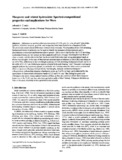Diaspores and related hydroxides' Spectral-compositional properties and implications for Mars
Metadata
Show full item recordAuthor
Cloutis, Edward A
Bell, James F. III
Date
2000-03-25Citation
Cloutis, E.A., and J.F. Bell III. "Diaspores and related hydroxides: Spectral-compositional properties and implications for Mars." Journal of Geophysical Research 105 (2000): 7053-7070.
Abstract
Differences in spectral reflectance properties (0.3-26 μm) of a suite of metal hydroxides (gibbsite, böhmite, diaspore, goethite, and manganite) have been found to be a function of both structural and compositional differences between these minerals. The properties of the O-H stretching fundamental bands in particular can be used to identify the presence of these minerals and to discriminate isostructural and heteromorphous species. This is due to the fact that the O-H stretching fundamental bands are very intense in these minerals and occur at longer wavelengths than those of other minerals, and also due to the fact that these metal hydroxides lack strong absorption bands at shorter wavelengths. In the case of dimorphous minerals such as böhmite (ϒ-A1O(OH)) and diaspore (α-A1O(OH)), differences in the wavelength positions of O-H stretching fundamental bands can be of the order of 0.1-0.3 μm. Reflectance spectra of metal hydroxide-bearing "ores" (bauxites) and impure samples indicate that accessory phases, in particular iron-bearing minerals, have a more pronounced eftect on spectral reflectance toward shorter wavelengths. Intimate mixtures of diaspore + orthopyroxene indicate that diaspore abundances as low as 5 wt% (or less) can be detected by the appearance of characteristic absorption bands at 3.33 and 3.41μm . This finding has particular relevance to the study of near-infrared spectra of Mars, in that the conditions which favor diaspore formation on the Earth may have also been prevalent early in Mars' history. If diaspore did form on Mars in the past, it is likely to have persisted to the present.

